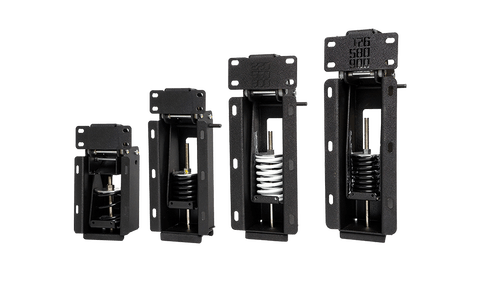
Vectis adjustable hinges are designed for precision, meaning adjusting soft-close hinges isn’t something to worry about.
Each hinge is built to match your specifications, providing smooth performance from the start.
Weight, size, and center of gravity are factored into the design, so these hinges work reliably without frequent adjustments.
Proper planning, installation, and setup help maintain performance. By taking the right approach from the beginning, you’ll get the most out of your Vectis hinge. This keeps operation smooth over time, allowing you to focus on the job without unnecessary fine-tuning or rework.
Adjustable Soft Close Hinges – Built for Precision
Vectis hinges are in a league of their own when it comes to customization. They are designed to your specifications, eliminating the need to adjust soft-close hinges while providing a precise fit for your application.
But what does this mean for you in terms of adjustment?
The answer is simple: you shouldn't need to make adjustments because these hinges are crafted to provide an optimal fit right from the start.
Once the hinge is manufactured, it’s shipped to you ready to install. There usually is no need to make any adjustments to the hinge, as it’s calibrated to your exact specifications. This means that when you install your custom hinges, they provide the counterbalance benefits you're looking for from the get-go, and you can trust that they will remain stable and effective over time.
6 Tips for Getting the Most Out of Your Adjustable Hinge
While Vectis hinges come ready to install without needing adjustment, there are a few things you can do to keep them performing well over time. Even if adjusting soft close hinges isn’t required, proper installation and maintenance help maximize longevity
- Follow installation guidelines – Proper installation helps the hinge function as intended. Carefully follow the provided instructions.
- Inspect for wear – Regularly check for signs of wear or damage. If any issues arise, reach out to Weber Knapp for assistance.
- Avoid overloading – Do not exceed the hinges' weight capacity, as this can affect performance.
- Skip extra lubrication – Vectis hinges are pre-lubricated with long-lasting, food-grade grease. Adding external lubricants can attract debris and may impact function.
- Make minor adjustments if needed – Changes in weight distribution or usage may require small spring tension adjustments to maintain smooth operation.
- Use available tools – Weber Knapp’s Vectis DYO app allows you to customize hinge specifications before manufacturing, reducing the likelihood of future adjustments.
Vectis DYO App: A Powerful Tool for Designing Custom Counterbalance HingesThe Vectis DYO app is a proprietary app from Weber Knapp that allows you to design your own custom counterbalance hinge. It is a powerful tool that can be used to create hinges for a wide variety of applications, from small lids to large doors. To use the app, simply input the three critical parameters of the load to be counterbalanced: lid weight, lid center of gravity, and horizontal and vertical distances. The app will then generate a torque curve that shows how much spring-based torque will be applied at different angles. You can then adjust the parameters to achieve the desired counterbalancing action. The app also allows you to specify the built-in open stop angle. This is the angle at which the lid or load will come to a stop when it is opened. This can be useful for preventing the lid from overextending or slamming shut. Once you are satisfied with the design of your hinge, you can submit it to Weber Knapp for engineering review and production. Try the Vectis DYO app here: |
If Adjustments Are Needed – Here's What to Do
Sometimes, despite precise engineering, you may find that your application's center of gravity isn’t exactly as expected. If you've already ordered your adjustable spring hinge and it’s out for delivery, there’s no need to worry. In applications like a lift hinge, small adjustments can help fine-tune performance and maintain smooth operation.
However, making these adjustments doesn’t have to be done alone. Contact Weber Knapp for professional assistance. Our team is well-equipped to guide you through the adjustment process.
With the right approach, your industrial hinges will continue to provide the counterbalance benefits you need while maintaining safety and long-term performance. Taking the time to make precise adjustments helps keep your system running reliably.
How to Adjust Vectis Spring Hinges: Step-by-Step
If you still need to make adjustments and feel comfortable enough to make them, follow these instructions. You’ll need:
- Two 9/16” combination wrenches
- Small ruler or similar measuring tool
Step 1: Open the lid and restrain it. This will prevent it from unexpectedly moving during adjustment.
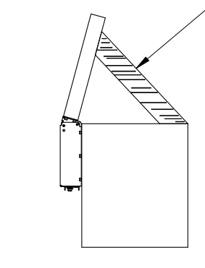
Step 2: Measure the spring setting dimension. During adjustment, do not exceed the upper or lower spring setting limits*. Otherwise, damage may occur.
*You can find these limits in the Vectis Design email you receive after purchase. If you haven't received this email, check your spam or junk folder. For further assistance, you can contact Weber Knapp.
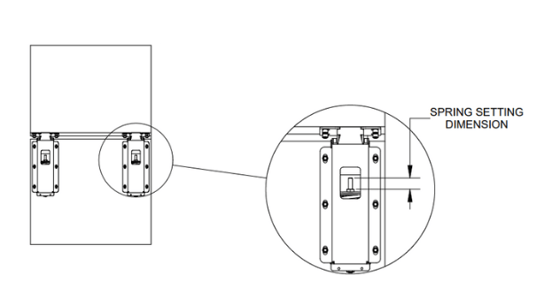
Step 3: Place one wrench over the top adjustment nut.
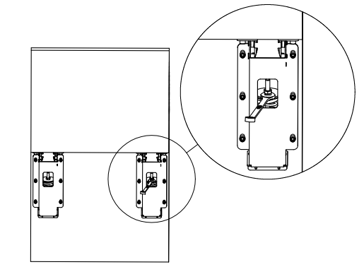
Step 4: Place the second wrench over the bottom adjustment nut.
- To increase the lift force, turn the lower wrench counterclockwise. The spring setting dimension will increase.
- To decrease the lift force, turn the lower wrench clockwise. The spring setting dimension will decrease.
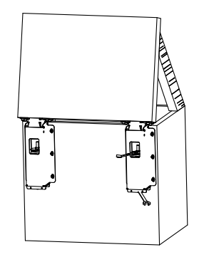
If you’d like a visual walkthrough of this process, Weber Knapp offers video tutorials that demonstrate hinge adjustments in detail. You can find them here.
How Do I Know if My Vectis Hinge Has Been Installed Correctly?
Proper installation allows the Vectis adjustable soft close hinge to function smoothly right from the start. After installation, the hinge should provide steady movement, supporting the lid or panel without unexpected shifts. A well-installed hinge will open and close without resistance, excessive force, or misalignment.
If the lid does not stay in position, feels too heavy to lift, or closes too quickly, there may be an issue with weight distribution or installation. Checking for signs of wear, loose mounting points, or improper alignment can help identify potential concerns.
For added confidence, you can contact Weber Knapp with questions or to verify specifications before installation.
Avoiding Adjustments | Perfecting Your Mechanical Hinge Design
The best way to avoid future adjustments is to plan ahead when adjusting soft close hinges during the design phase.
Weber Knapp provides models on our website to help you see how Vectis adjustable hinges will function in your setup, making it easier to finalize your design.
For applications with non-traditional mounting, our team can assist by determining the center of gravity and providing guidance on weight distribution.
A thoughtful approach to mechanical hinge design helps reduce the need for adjustments later, keeping your system running smoothly.
Need Help? Contact Us
Weber Knapp's Vectis hinges are the epitome of customized, precision-engineered solutions for your applications. We believe in getting it right the first time to ensure your hinges fit perfectly without constant adjustments.
Need help with your Vectis hinges? Contact us today! We're happy to help you get the most out of your investment.
This article was originally published in November of 2023 and was recently updated to reflect current industry standards.
.png?width=12000&height=2033&name=WeberKnappLogo_white%20(1).png)



